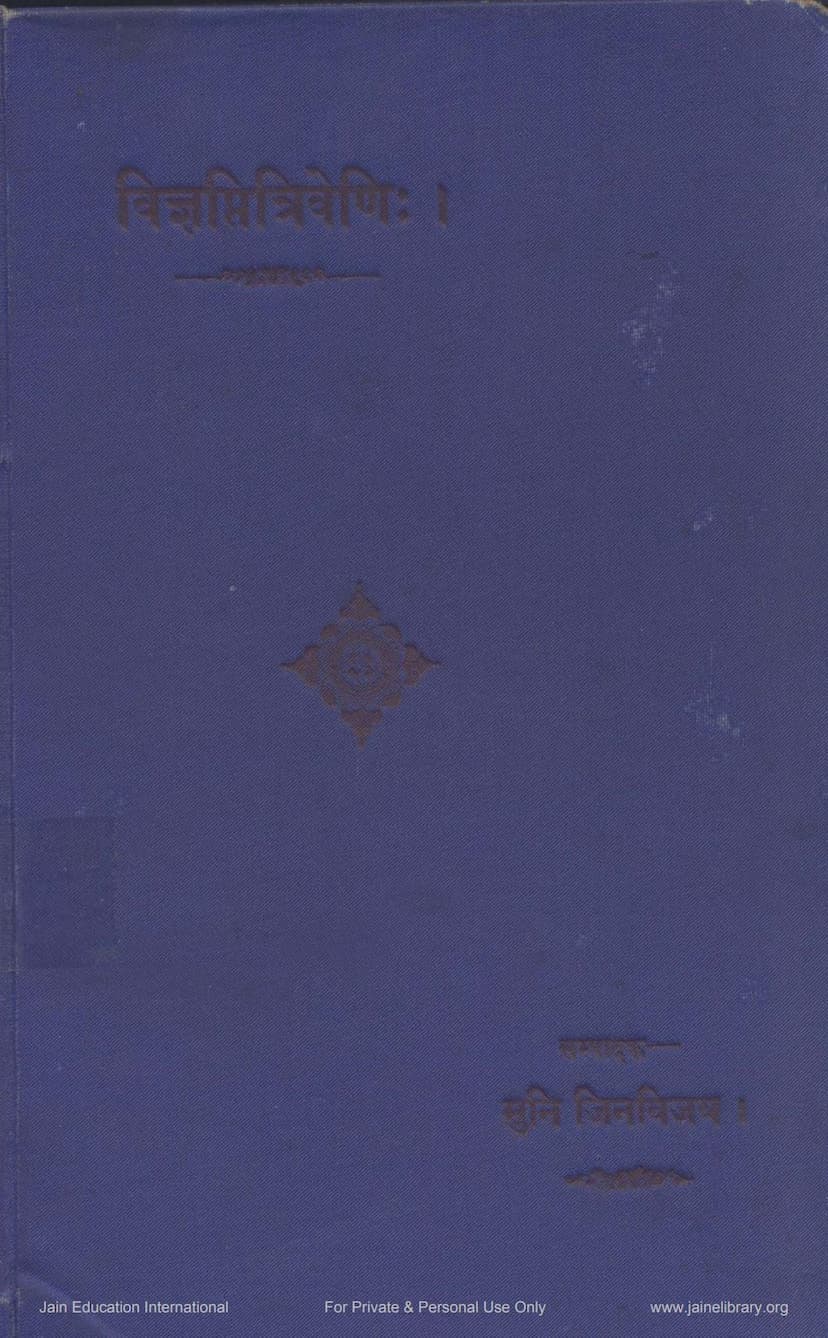Vignaptitriveni
Added to library: September 2, 2025

Summary
This document is a summary of the Jain text "Vignaptitriveni" (विज्ञापत्रिवेणिः), edited by Muni Jinvijay, published by Atmanand Jain Sabha, Bhavnagar, and printed by Laxmivilas Press, Baroda, on September 22, 1916. It is the first publication in the "Kantikavijay Jain Itihasmala" series.
The core of the text is a collection of "Vijnapti-patras" (विज्ञप्ति-पत्र), which are historically significant Sanskrit letters, often elaborately written, sent from Jain monks or congregations to their Acharyas (religious leaders). These letters served multiple purposes:
- Sanvatsarik Kshama-pana: Expressing apologies for any offenses committed during the year, especially during the Paryushan festival.
- Religious Report: Describing the religious activities undertaken by the local Jain community during the Paryushan festival.
- Invitation: Extending an invitation to the Acharya to visit their town or monastery.
Key Features of Vijnapti-patras:
- Elaborate Format: Historically, these letters were written on long strips of paper (sometimes up to 60 feet), adorned with numerous pictures depicting various scenes like religious symbols, palaces, markets, temples, natural landscapes, and even everyday life.
- Content: They typically included laudatory verses about the Acharya, descriptions of the places visited by the monks, accounts of religious observances, and humble requests for the Acharya's visit. They could also contain historical and political information relevant to the period.
- Language: Written in a mixture of Sanskrit and Prakrit, with both prose and poetry.
The book "Vignaptitriveni" itself is a collection of three such "Vainis" (वेणिः) or streams of Vijnapti-patras. The editor, Muni Jinvijay, highlights the importance of these letters as historical and literary documents, often overlooked and decaying in ancient manuscripts.
Notable Vijnapti-patras discussed in detail:
-
Induduta (इन्दुदूत) by Mahopadhyaya Shri Vinayavijayji: This is a khanda-kavya (short epic poem) written in imitation of Kalidasa's Meghaduta. The poet uses the moon as a messenger to send his vijnapti to his Acharya. The poem details a journey from Jodhpur to Surat, describing various locations with rich cultural and geographical details, including famous Jain temples like those at Abu. The poem is praised for its literary merit and the poet's observational skills, despite some geographical inaccuracies for narrative purposes.
-
Meghaduta-samasya-lekha (मेघदूतसमस्यालेख) by Mahopadhyaya Shri Meghavijayji: Similar to Induduta, this vijnapti is also a problem-completion (samasya-purti) based on Kalidasa's Meghaduta. Here, the cloud itself is the messenger. The letter describes a journey from Aurangabad to Div, also detailing places and natural sceneries, with specific mention of important Jain sites like Ellora and the temples at Mount Girnar. The poet also touches upon the political instability of the era.
-
Chetoduta (चेतोदूत): Another vijnapti that uses a problem-completion technique from Meghaduta. In this case, the poet's own mind (cetas) serves as the messenger. It is written in a more general style, avoiding specific names, to make it applicable to a wider audience and context.
-
The Largest Vijnapti-patra: The text mentions a colossal vijnapti-patra by Munisundarsuri, measuring 108 hands in length, containing hundreds of pictures and thousands of verses. It served as a detailed chronicle of the Tapa Gachha lineage.
Other Important Sections:
- Antiquity of Vijnapti-patras: The tradition of writing such letters is considered very old, with the oldest discovered manuscript dating back to the 13th century and written on palm leaves.
- Jinvijayji's Research: The editor, Muni Jinvijay, mentions his extensive research into ancient Jain manuscript libraries, particularly those in Patan and Jaisalmer, facilitated by Acharya Kantivijayji.
- Jinbhadra Suri: A significant portion is dedicated to the life and works of Acharya Jinbhadra Suri, highlighting his role in establishing numerous libraries and his scholarly contributions.
- Jay Sagar Upadhyay: The life and works of Jay Sagar Upadhyay, the author of the "Vijnapti-Triveni" itself, are discussed. His travels, his religious writings, and his disciples are detailed.
- Nagar Kotta Mahatirtha: Extensive information is provided about Nagar Kotta (modern Kangra), identified as a significant ancient Jain pilgrimage site. Historical accounts, archaeological findings (inscriptions and statues), and its eventual decline are discussed. The writer appeals for the restoration of this forgotten pilgrimage site.
- Additional Information: The book also includes details about the disciples and lineages of prominent Jain scholars and Acharyas, illustrating the rich scholarly tradition within Jainism.
The entire work emphasizes the importance of preserving and studying these historical Jain documents, which offer invaluable insights into the religious, social, and cultural history of Jainism in ancient India. The editor expresses his dedication to bringing such hidden treasures to light for the benefit of the Jain community and historical researchers.